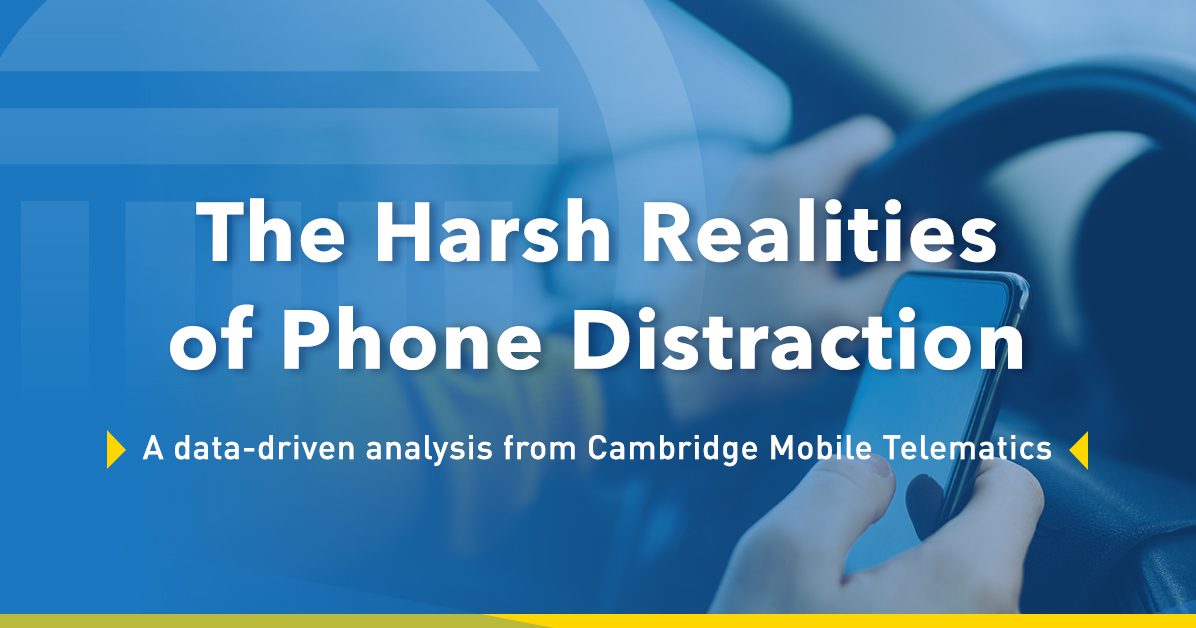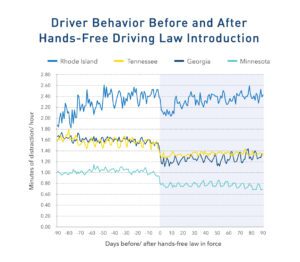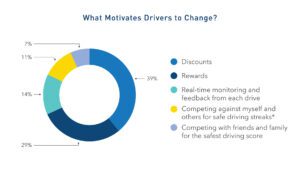Eliminating Distraction will Require Both State and Individual Approaches

In previous installments in this blog series, CMT highlighted how society has been slow to respond to the phone-based distraction problem. Most people misunderstand just how dangerous phone use behind the wheel is. In fact, 41% of daytime trips involve at least one phone-based distraction event.
The resulting lack of urgency is the main culprit for the mixed responses from governing bodies. To date, no state has a full ban on phone use while driving, and in the states with hand-held laws, tickets are rare, averaging only 700 fines per year per 100,000 licensed drivers in 2018.
Besides the lack of serious enforcement, these laws have not proven to be effective: analysis using telematics shows many implementations have not generated sustained changes in driver behavior over time. We analyzed tens of millions of trips in four states where a hands-free law went into effect: Rhode Island (June 1, 2018), Georgia (July 1, 2018), Tennessee (July 1, 2019), and Minnesota (August 1, 2019). The resulting data shows that while there was an initial drop in phone use, it was only temporary.
The graph below illustrates the behavior change based on the measurement of distracted minutes per hour using telematics. All four states saw an immediate drop on the day the law went into effect. This shows the immediate effect of public awareness campaigns, and the fear of being punished for bad behavior.

However, all states but Minnesota saw a quick subsequent regression towards previous levels of distracted driving, with gains eroding quickly after the initial bump.
Additionally, the research revealed that while most states saw improvement from the enactment of new laws erode quickly, there were populations who saw sustained behavior change. A portion of drivers even showed significant improvement that extended beyond the 90 day study. These “frequent drivers” were in fact telematics program users that were separately identified as frequent users of their safe driving apps.
The distinction is an important one because it demonstrates that in the group of users that interacts with their telematics app frequently (at least once in 20 out of 24 weeks), as many as 48.5% still see sustained improvement 90 days after.
Clearly telematics has been very useful in measuring the size, evolution, and nature of the distraction problem, but now we have demonstrated it can also help solve it.
Yet at a state level, changing behavior is a different issue. Regulations and enforcement alone have not proven enough to curb phone-use behind the wheel, nor have ad campaigns or the increase in general public awareness. As such, the challenge of curbing distraction now lies in authorities’ ability to evoke a willingness to do so in drivers.
Drivers must be motivated consistently to change. Simply making them aware of their risky behaviors and deterring them from engaging in them once is not enough.

When we asked drivers what motivated them to change, the results showed that they are more inclined to change for financial gain or to satisfy their ego, such as earning discounts or winning a competition. Two caveats also became apparent: for the motivators to be effective, they must engage the driver in such a way that:
- The driver is aware of their driving behavior, and
- They are empowered to change it.
One framework responding to the above demand is the Safest Driver Contest. One such competition is currently running in Canada and CMT has been supporting many of them in the U.S. at a city level.
In 2020, the Safest Driver contests were nationally recognized as a success story by the Federal Highway Administration. They are a perfect marriage between public and private entities. The results of these contests are detailed in our report “The Harsh Realities of Phone Distraction.” Download the report here.